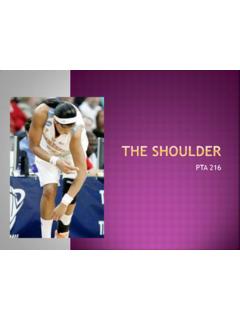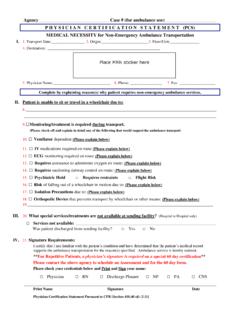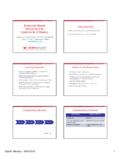Transcription of Review of diagnostic criteria for work related upper limb ...
1 A Review Of diagnostic criteria For work related upper Limb Disorders (WRULD). Professor Alan J Silman MSc MD FRCP FFPHM. Jason Newman BSc Arthritis & Rheumatism Council Epidemiology Research Unit University of Manchester, Medical School Manchester February 1996. Table of contents Acknowledgements 1 Introduction work related upper limb disorders Classification of WRULD. Structure of this Review Section I Non-Specific work related upper Limb Disorders 2 Omnibus terminology Concepts of work related upper limb disorders Overuse syndrome Cumulative trauma disorder (CTD). Repetitive Strain Injury Chronic upper limb pain syndrome Summary Section II Regional Syndromes Of The upper Limb 3 Hand and wrist disorders Introduction Carpal tunnel syndrome (CTS). Cubital tunnel syndrome (CUTS). Radial tunnel syndrome Ulnar tunnel syndrome Pronator and anterior interosseous syndrome Tenosynovitis De Quervains tenosynovitis Intersection syndrome B e a t h a n d Hand and wrist pain 4 Disorders of the elbow Epicondylitis Lateral epicondylitis Medial epicondylitis Beat elbow and olecranon bursitis 5 Conditions affecting the shoulder Painful shoulder Bursitis Tendon related disorders Tendinitis of the shoulder Bicipital tendinitis Infraspinatus tendinitis Supraspinatus tendinitis Subscapularis tendinitis Rotator cuff lesions Impingement syndrome Frozen shoulder Section III Vibration Exposure 6 Hand-arm vibration syndrome Vibration Vibration disorders Hand-arm vibration syndrome 3.
2 Vibration white finger (VWF). Appendices 7 Nomenclature Introduction Hand and wrist disorders Elbow and shoulder disorders Omnibus disorders Disorders of vibratory origin 8 International classification of disease 9 References '. Acknowledgements We would like to thank Andy Slovak for his considered opinions that helped to finalise the project and Peter Nicholson, for generously allowing us access to his database. 4. 1. 1. Introduction work related upper limb disorders Employment related medical conditions affecting the upper limbs have become a problem of increasing concern around the world. The so-called work related upper limb disorders (WRULD). are significant contemporary occupational health problems, estimated to affect many millions of workers around the world annually. The term upper limb disorder encompasses a variety of musculoskeletal problems, affecting the tissues of the hand, wrist, arm and shoulder.
3 Such problems are relatively common in the general population. Regarding the workplace, WRULD is an umbrella term for conditions thought to be caused by exposure in the workplace. Alternative terms for this are overuse syndrome, repetitive strain injury (RSI) and cumulative trauma disorder (CTD)..i Causes of WRULD. A basic hypothesis exists that WRULD are caused, aggravated or precipitated through a worker's need to exert undesirable force, use uncomfortable hand grips, or adopt static awkward postures in the workplace, coupled with continuous repetitive work and insufficient rest or recovery. 1 .1 .ii Disagreements over WRULD. Recently musculoskeletal disorders affecting the upper limb have received considerable attention, following financial claims for damages from employees considered having developed work related upper limb disorder.
4 In a field increasingly influenced by legal proceedings, important differences in opinions still exist, for instance how the disorders should be defined. The term repetitive strain injury' is medically imprecise. A more descriptive title would be regional pain syndrome'. Controversy also arises from whether certain disorders, such as carpal tunnel syndrome (CTS) are related to the workplace ergonomic factors. Although some of these conditions are known to be related to non-occupational risk factors, such as pregnancy or rheumatoid arthritis, occupational factors play an important aetiological role in other cases. Classification of WRULD. The primary purpose of this synopsis, using all the current available literature, is to provide a Review of diagnostic criteria for work related upper limb disorders. These occupational related upper extremity disorders can be classified in two ways: 1.
5 By their site of origin: Shoulder ( painful shoulder Syndrome). Elbow ( epicondylitis). Wrist/Hand ( carpal tunnel syndrome). 2. In relation to their purported cause, vibration white finger (VWF). Classification using the latter, even if proof of a link is absent, implies a syndrome of occupational origin, whereas the former, does not distinguish morbidities that arose from the workplace from those that arose sporadically. criteria for diagnosis and classification In this Review we will present criteria for diagnosis and for classification. The two are distinct notions. diagnostic criteria are of value to the clinician to make considered decisions about a patient's possible condition. By necessity these criteria need to include the possibility of atypical cases and thereby span the spectrum of available presentations. Classification criteria , by contrast, aim to identify homogenous subgroups for the purpose of study.
6 In grouping individuals like this, some with the disorder may be classified as negative and vice versa. This is an accepted problem, but the aim of such classification criteria is to maximise discrimination between those with the condition under consideration from those with which it might be confused. From a medico-legal stand point, it is important that failure to satisfy classification criteria does not exclude the possibility that an individual might have the considered syndrome. Structure of this Review For the purposes of this report the issues of classification will be considered in three sections. First the use of omnibus terms to cover groups of anatomically heterogeneous disorders, though collectively known to be work - related . will be reviewed. This includes such concepts as WRULD, CTD and RSI. Secondly the various individual upper limb syndromes will be reviewed as distinct entities categorised by organ at the site of involvement.
7 This includes broad areas, shoulder; and specific anatomical structures, extensor tendinitis. Thirdly the relationship between vibration exposure and upper limb morbidity alternatively termed vibration white finger (VWF) and hand-arm vibration syndrome (HAVS), will be reviewed as a separate item. The Review will cover the various definitions that will be used both for diagnosis and classification and separately consider, where available, grading for severity. In addition, for some disorders, classification has been attempted by level of exposure. Sources of literature A systematic literature search was undertaken using standard online retrieval systems. Medline', Embase' (Excerpta Medica) and ISI (Science & Social Science Index) citations were examined, from the Bath Information Delivery System (BIDS); as was the Occupational, Safety and Health 6.
8 CD-ROM database. Standard textbooks of rheumatology. orthopaedic and musculoskeletal medicine were used to obtain details and references and then a hand search instigated to further relevant publications, within the English language literature. Search criteria Literature was sought that contained information pertaining to the classification or diagnostic criteria of anatomically based (ie. shoulder, elbow, wrist etc.) or occupationally based ( repetitive strain, vibration white finger etc.) disorders of the upper limb. Consideration was also given to sources of workplace ergonomic criteria ( task variables) and classification ( occupational types). s Section I. Non-Specific work related upper Limb Disorders 9. 2. 2. Omnibus Terminology Concepts of work related upper limb disorders The term work related upper limb disorder (WRULD) encompasses a variety of clinical syndromes of the upper extremity disorders that have resulted from occupational trauma.
9 A. number of other terms have been used which probably describe the same entities but in the strictest sense do not overlap completely. This can be represented simply by the Venn diagram shown below in figure \. / upper Limb Disorder Figure work related upper Limb Disorder is an umbrella term..i An umbrella term All three terms, repetitive strain injury (RSI), cumulative trauma disorder (CTD) and overuse syndrome are clearly broadly synonymous, aiming to identify the same entity. Confusion arises as applying published criteria would select as positive' different individuals for each of these. 10. However, in the current literature there is no comparison of the performance of the use of such terms. Definitions are available, but these are not helpful as working criteria and as such there are no published criteria . Overuse syndrome Overuse syndrome is a recent term to describe work related upper limb disorders.
10 The syndrome describes musculoskeletal disorders characterised by pain, tenderness, and often functional loss in muscle groups and ligaments subjected to heavy or unaccustomed use( ,*). Tears of the muscle- tendon junction, due to high (eccentric) loads are the most obvious pathology; more likely, though less visible, are micro tears within the tendons after undue loading(3). Tenosynovitis (synovial thickening) can occur due to friction. Fatigue also results from the disruption of the muscle due to static contraction. Hypoxia presents in nerves around the affected region from compression of blood supply by the tendon and muscles Grading Only one criterion for grading has been proposed for overuse syndromet4), which includes three stages of severity: Stage 1 - Mild when at work . Stage 2 - Moderate severity lasting more than two hours into the evening.













